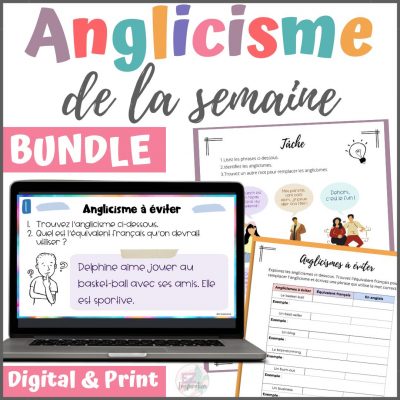
I remember when I heard the expression, “Comprehensible Input” for the first time. I was intrigued because many language teachers started using the term and claiming that it was essential in French Language Education. I couldn’t resist diving into the research behind it and discovering how I could incorporate it into my classes.
Comprehensible Input is an essential aspect of language learning that French teachers should use in their classrooms. When using Comprehensible Input, the language learning materials are tailored to the students’ proficiency level. When using comprehensible input in the classroom, students are able to make sense of the language, without using their native language.
In this blog post, I will discuss the importance of this instructional technique and how French teachers can incorporate it into their lessons to enhance their students’ learning experience and French proficiency.
The Importance of Comprehensible Input
The concept of comprehensible input is based on the research of Stephen Krashen. Krashen was a linguist who observed that learners are able to acquire a new language naturally when instruction is delivered in the target language one level above their current proficiency level. In other terms, learners are exposed to language structures that are slightly more complex than what they already know.
When learners receive Comprehensible Input, they are not just exposed to new vocabulary and grammar structures, but are also given opportunities to practice and acquire them. Then learners are able to progress in their language proficiency by receiving Comprehensible Input and practicing the language structures and vocabulary until it becomes part of their linguistic repertoire.
When using Comprehensible Input in the classroom, there are many benefits in the classroom :

Increases language proficiency as learners are exposed to more vocabulary and grammar structures in an authentic context
Enhances motivation and participation as students are able to accomplish tasks tailored to their appropriate level. Therefore, they are able to understand the content, interact with their peers, and feel more motivated to learn the language
Improves comprehension as the learning materials and tasks are tailored to the students’ proficiency level, making it easier to understand and they have more success communicating with native speakers
Develops confidence as learners have authentic opportunities to practice their language skills at a level that they are comfortable at
Provides cultural exposure as learners are exposed to authentic cultural materials such as texts, audiovisual media, and conversations.
Incorporating Comprehensible Input in the French Classroom
In order to incorporate this instructional technique in your classroom, the teacher needs to identify their students’ current proficiency levels and the proficiency level that their students are working towards. Delivering Comprehensible Input is similar to scaffolding, except you are focusing on content knowledge and language proficiency in the domains of reading, speaking, listening and writing. There are many ways that French teachers can incorporate Comprehensible Input in their daily lessons. Here are a couple of suggestions :
1. Use Authentic Materials

Authentic materials are texts, clips and audios that are created for native speakers and learners of the target language. Using authentic materials in the French classroom can expose learners to the language as it is spoken in real-life situations. Authentic materials can include French songs, TV shows, news articles, etc. These materials can be used to introduce learners to new vocabulary and grammar structures, which they can practice through comprehension activities.
2. Personalization
When you are able to adapt your lessons to your students’ interests, students are more engaged and invested in learning French. During the World Cup, I had many students who were obsessed with soccer. Therefore, I decided to teach about the World Cup and some of the famous French players. We watched some of the match recaps in French and even wrote a paragraph, predicting the winner of the competition and our reasons why. I was able to personalize my content by incorporating a high-interest topic that interested my learners, and expanded their French vocabulary and exposed them to new grammatical structures at the same time. Some other ideas would be targeting other learners’ interests such as music, food, or sports.
Daily routines involve repetitive actions and tasks that learners complete in a context that is familiar and understandable. When using daily routines, students are exposed to language input that is contextualized and relevant to their everyday lives. This familiarity makes it easier for learners to understand and acquire the language used to describe these tasks in the target language. These routines allow students to build confidence over time, gain insight to the French language and culture, and enhance their French proficiency. Some examples of daily routines that you can incorporate in your French classroom
Lecture du lundi – read a short text and answer 3 simple questions in French
Mardi – learn a new French idiomatic expression and write a sentence using it in context
Musique Mercredi – show a francophone song and highlight the message & its themes
Jeu du Jeudi – play a short game in French
Virelangue du Vendredi – French tongue twister competition
4. Gestures and Visuals
When teachers use a variety of gestures and visuals in the classroom, they are able to make language input more comprehensible. French teachers should use gestures and visuals to accompany new vocabulary and grammar structures. This will allow these concepts to be more memorable and easier to understand for their learners. Visuals can be used to support language input by providing pictures or videos to illustrate these new terms.
5. Simplify Language
Teachers can simplify language input by using simple sentences and structures and avoid complex vocabulary. For example, avoid using idiomatic expressions or complex verb tenses if your students are not at an advanced level. By using language that is tailored to the learner’s proficiency level, teachers can help their students make sense of the language that they are learning.
Conclusion
Comprehensible Input is an important concept in our 21st century French classrooms and teachers are strongly encouraged to incorporate it into their lessons to enhance their learners’ French proficiency. Give your students the gift of confidence and create a more engaging, inclusive, and stimulating classroom environment.
Feel free to leave any questions or share some of the ways that you incorporate Comprehensible Input into your French classroom below.
Bonnes classes,
Emily



